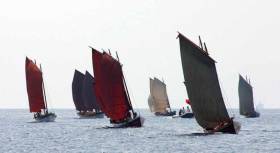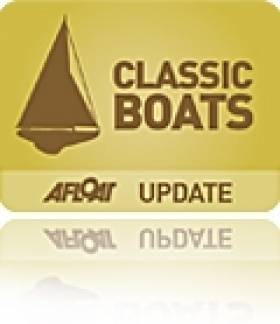Displaying items by tag: Bantry longboat
The Bantry Longboat Fionnbarra, community-built by Meitheal Mara, and with rig perfectly set up, made an impressive sight in the Autumn sunshine of Cork Harbour at the weekend.
The 2007 built boat had been the focus of a refurbishment project in 2019 and is now back on her home waters of the River Lee in Cork city and the lower harbour area.
With ten oars and three dipping lug sails these boats provide a great medium to teach different elements of seamanship and test both rowing and sailing skills of crews.
 Bantry longboat Fionnbarra brings people out on the water who would not normally get the chance Photo: Bob Bateman
Bantry longboat Fionnbarra brings people out on the water who would not normally get the chance Photo: Bob Bateman
Most sailing folk in Ireland will have some level of awareness of the Bantry Boat. Even those who live most determinedly in the present, and look unswervingly to the future, will be vaguely aware that thanks to some fortuitous turns of history, on both sides of the Atlantic, we now have flotillas or individual examples of sailing/rowing craft of a classic design which is pushing towards being 250 years old and more in its origins.
Old they may be in concept, yet these boats provide a valid combination of rowing and sailing for seamanship and adventure training which has a special resonance today, and in coastal communities, they can be a focal point for active maritime involvement as Afloat's WM N Nixon relates here.
11 International teams will make Antrim their home for the International Contest of Seamanship tomorrow.
As Afloat.ie reported previously in March, 200 young people from USA, Russia, St Petersburg, Belgium, Ghent, GB, Ireland, Quebec, France, Denmark, Canada and Northern Ireland will compete, live and learn together.
During the week long contest the 38ft wooden gigs will be sailed and rowed. Teams will undertake various skill tests, including navigation, rope work, Jack Stay Transfer, Captain’s Gig, Slalom and Man overboard rescue.
Spectators will have a great view from the Lough Shore of the 11 picturesque gigs as they race on Lough Neagh.
The contest takes place every two years and Northern Ireland has competed in Canada, Finland, Ireland, Italy, France and Denmark in 2016.
"The Challenge for the crew is to learn to sail and row a 38ft Captain’s gig and use it in friendly contests"
The Challenge for the crew is to learn to sail and row a 38ft Captain’s gig and use it in friendly contests, including the biennial contest of seamanship with young people of other nations. To build a team that makes new friendships, new understanding and builds trust that spans frontiers. Also to be ambassadors among people of other nations, competing overseas in one of the member nations.
The gigs are replicas if 18th-century admiral’s barges, used by fleets in harbour for transport between ships and shore. The design was drawn from a French naval model, but such boats were common two centuries ago to the navies of Britain, France, Russia Spain and Sweden. Technically they are long boats but common usage and history have led Atlantic Challenge to use the term “gigs” or “Bantries. The model from which they are built dates from the French invasion of Ireland at Bantry in 1796.
Northern Ireland has had 2 gigs Harmonie was launched in 2003 by Dame Mary Peters and the crew are now sailing Cwch John Kerr, named after the boat builder credited with bringing the organisation to the UK.
We are a cross community, cross gender organisation, giving equal prominence to all individuals in our team. We welcome applicants from all corners of Northern Ireland. Our gig Cwch John Kerr is based at Antrim Boat Club on Lough Neagh.
Northern Ireland became World Champions in 2012.
Dame Mary Peters is our Patron and will open the International contest in Clotsworthy Gardens.
The contest will start in earnest this Saturday morning, with at least two races or tasks every day for the week. This is a strong test of the crew’s physical strength and endurance as well as requiring teamwork, quick thinking and ingenuity. All teams striving to be World Champions.
The experience of mastering the gigs, living with people from other cultures and learning new skills is life-changing for the young people. They grow in confidence, life experience and make new friends. The experience of the contests is something the crews will never forget.
It is an honour for Antrim Boat Club to be chosen to host this Contest. The visitors are all looking forward to enjoying the welcome, sights and traditions of Northern Ireland.
The Northern Ireland crew is made up of approx. 20 young people from the local area, Antrim, Randalstown, Doagh and Templepatrick with previous crew returning from Glasgow, New Zealand and Guernsey for this important contest. Under the expert supervision of Michael Patton the cox, the crew have been training every Sunday at Antrim Boat Club to prepare for the contest.
The opening ceremony will take place in Clotsworthy Gardens at 4:00 on Friday 20th July 2018. Everyone is welcome to view the teams and contest.
#tallship – The first Bantry Longboat ever built in the Midlands will go sailing on the Shannon at Banagher in County Offaly. It will be some sight when it does, bringing involvement with the Atlantic Challenge which organises international competition of these boats, to what can fairly be described as Ireland's greatest river system.
If that major event should itself be held in future years on the Shannon, what a great occasion it would be.
I met some of those who built it the Banagher Longboat at the Glandore Classic Boats Summer Maritime School where one of them, Noel Ryan, told me that it took 5,036 man hours. Another of the group, Willie Kirwan, added that they would have "done it quicker if we were tradesmen, but we were all learners without experience, so we had a lot of tea breaks! If we were tradesmen we would have been quicker, but we enjoyed it and we have a fine boat."
They have indeed and those who built it will be testing it out in August. "We want to make sure it goes well, we wouldn't want any embarrassment," said Willie jovially, "but we are sure it won't sink, though we will have to learn about the skill of rowing and sailing this boat."
Indeed they will. I had the pleasure of sailing in the Bantry Longboat which was built in Bantry a few years ago. When it sailed on a reach it could reach a pretty quick speed and I found it was the skill of the crew in balancing the boat which kept it upright. You needed to be lively, as the longboat doesn't have a keel.
"We learned a lot, new things every day, building a boat can be tough and demanding but it is definitely enjoyable and rewarding when you see it finished," Noel said.
They have a lot of pride in their boat which was built with as the West Offaly Bantry Bay Longboat Project, originally a Men's Shed initiative with support from Offaly Local Enterprise Development Company, West Offaly Enterprise and County Offaly VEC, the latter of whom apparently thought the job might be done in three months!
The boat has led to the formation of the Midlands Atlantic Challenge Club, which intends to organise involvement with schools, youth, sports and corporate groups.
Twelve countries are members of the Atlantic Challenge organisation – Belgium, Canada, Denmark, Finland, France, Great Britain, Indonesia, Italy, Russia, USA, Ireland and Northern Ireland are separate members.
The original longboat, also known as an admiral's barge, was built in Brest, France, over 200 years ago. The boat is similar to the Captain's gigs used at that time by the navies of France, Sweden, Russia, Spain, Sweden and the USA. When the French Armada arrived off the South/West coast of Ireland in 1796 it ran into a gale and, through lack of leadership, decided to return to France. But the longboat from the vessel which Wolfe Tone was aboard, while trying to establish communication with other ships, was blown ashore in Bere Island and the crew were captured by British forces. This boat is preserved in the National Museum at Collins Barracks in Dublin. Built in1790, it is the oldest surviving vessel of the French Navy.
So, what have these Bantry Longboats got to do with whether Ireland should have a tall ship?
Hal Sisk, legendary figure in the traditional boats sphere and a man never reluctant to take and express a different view and to advance that, even if controversial, was also speaking at the Glandore Summer School in his role as sailor, author and yachting historian, on the topic: 'The origins of the sport of modern amateur sailing.'
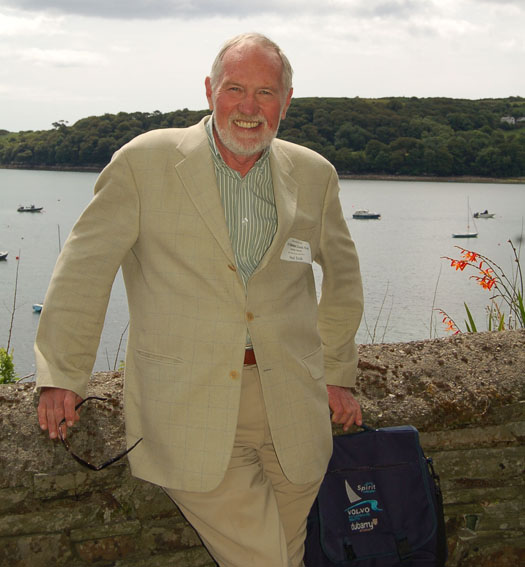
Hal Sisk
Hal advanced a different view about the thrust of sail training than Ireland having a tall ship for the purpose:
"To get people out on the water, in a team concept, providing physical exercise and with international competition, all of that could be achieved with an alternative of a fleet of 30 Bantry Longboats, several of which have already been built in Ireland. There are 35 worldwide and a fleet of them in Ireland would provide, at dramatically reduced cost, what a sail training ship delivers in sail training."
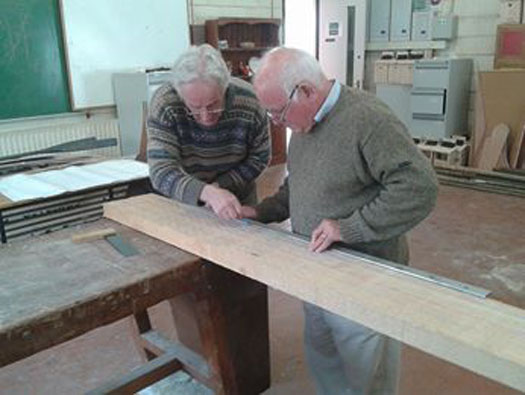
Building The Banagher Bantry Longboat
I put it to him that this would exclude the role of international representation which, for example Asgard had done well and, in modern terms, requirements to provide for disabled trainees.

Bantry Longboat Fionbarra
"I acknowledge what you say, but these boats have fantastic international competition. They are all built the same wherever they are, whereas in the race of sail training ships, it is pretty much based on handicap, it is not a race between identical boats. The Bantry longboats provide this, they come together every few years in international competition and have been built far away, in Indonesia, Russia, for example. You would get true, fair, international competition. They don't fly the flag in a spectacular way in international representation terms as Asgard did for example or as does a beautiful square-rigged tall ship, but there always was an alternative in the replacement of Asgard after she sank.
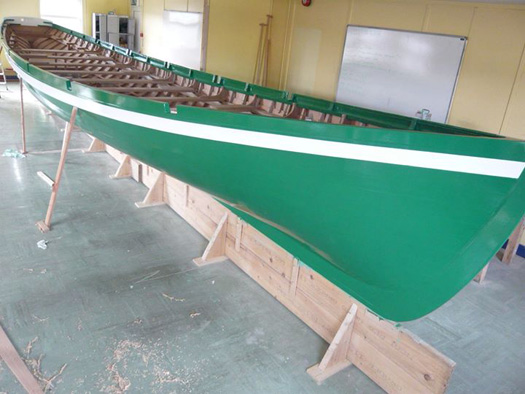
The Banagher Bantry Longboat
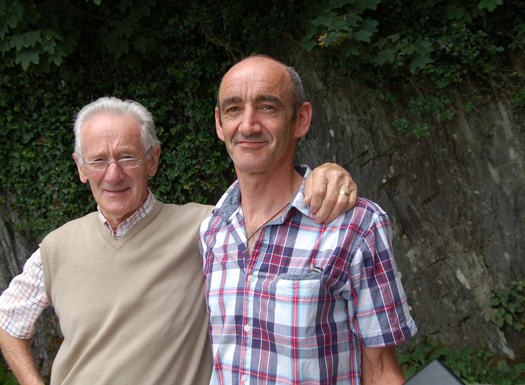
Willie Kirwan And Noel Ryan - Banagher Boat Builders

The Oldest Vessel Of The French Navy - The Original Bantry Longboat In Ireland's National Museum
"Ireland could have bought a steel-hulled topsail schooner for about €2m, or so and have her for that function, but I would argue that, as against the building of a new tall ship we could build a fleet of Bantry Longboats. We must also remember the cost of maintenance and operation of a tall ship, crewing and health and safety requirements. But a fleet of Bantry longboats would be out on the water far more often probably and could be built for maybe a million and would provide more use for more trainees and the cost, against that of a sail training ship, would not be just very much less, but substantially less by my calculations."
Hal has sent me statistics to make his point - that actual use and benefits in providing sail training and general seamanship for many more young people would be at much less cost for a fleet of 30 Bantry Longboats compared to a tall ship and would be of much greater benefit.
"Bantry Longboats could be spread around the country, built locally and therefore also building on town and parish pride and maintaining coastal traditions also. It is a historic boat, authentic, distinctive, with that huge international competition dimension."
The case Hal Sisk makes is interesting, while at present efforts continue through what was formerly called the 'Pride of Ireland Trust' now changed to the 'Atlantic Youth Trust,' to build a new Irish tall ship, the concept design for which has been completed. The name change followed consultation on both sides of the Border, after which it was decided that 'Pride of Ireland Trust' did not represent the views of all stakeholders and "therefore did not represent the ethos of the organisation, so in order to create a name that has a true sense of neutrality, a strong maritime focus, a sense of adventure and one that carries weight in America, 'Atlantic Youth Trust,' was chosen as the name to offer unique Youth and Cultural Development opportunities, to help the island reach its maritime potential and to create a flagship that will represent the island on an international platform," amongst other aims.
I will be interested to hear response to the views of Hal Sisk.
THE GOVERNMENT IS HOLDING €3.8m. IN ASGARD COMPENSATION WHICH IT SHOULD RETURN TO THE MARINE SECTOR
It remains a blot on the maritime reputation of this island nation that the €3.8m. insurance paid for the loss of Asgard was put into general Government funds by former Defence Minister Willie O'Dea, rather than being held for the specific purpose of a replacement national tall ship, even if that would be provided outside of Government.
I was never impressed by the administration of Asgard during my years as a national marine correspondent. I expected far more commitment and determination in support of the maritime interests of this nation. When Willie O'Dea appeared to confuse 'vehicle' and 'vessel' in his answers on a radio interview about the sinking of Asgard, then refused several attempts by me to get an interview with him about his decision in regard to giving the Asgard insurance money to the State and other decisions he made when the equestrian requests of the Army for horses, were considered more important than Asgard, I realised that the Limerickman who declares on his website - 'Working for You' - did not show much commitment to working for the national tall ship. I offered to go anywhere, anytime, to interview him, but through his officials, he always found a reason not to be available.
Whether for Bantry Longboats or for a tall ship, it is my view that there is €3.8m. in State funds which is morally due to either project and the Government should acknowledge and provide that.
No less is required of the Government of an island nation.
Bantry Longboats Head for Glandore's Classic Regatta
The pilot cutter "Jolie Brise" will be taking part in the CH Marine Glandore Classic Regatta next July as part of her centenary celebration.
The Jolie Brise won the inaugural Fastnet race in 1925 and again in 1929 and 1930. She still holds the record for the most wins in the Fastnet race. She was described, by January's 2013 Classic Boat magazine, as "one of the most famous yachts ever".
Making return visits to Glandore this year are super yacht "Blue Leopard", famous Fife yacht "Solway Maid" and local schooner "Spirit of Oysterhaven".
There are several boats coming from the UK including five Anglesea Fifes and the Welsh Bantry Longboat "Integrite".
There will also be four Irish Bantry Longboats taking part. Among the other Irish boats this year will be Jarleth Cunnane's "Northabout" of North West and North East Passage fame and Michael Brogan's Galway Hooker "Mac Duach".
New events this year will include an overnight cruise to Castletownshend and an island picnic. Popular events again this year include a Fireworks display, Parade of Sail and street party. There will also be a full entertainment programme including Jimmy Crowley in concert, Two Part Polka and Welsh Male Voice choir in Glandore Church.
The week will include something for everyone, sailor and non-sailor, people afloat and ashore and those who just come to enjoy Glandore and the ambience of a great scene onshore and beautiful boats under sail.


























